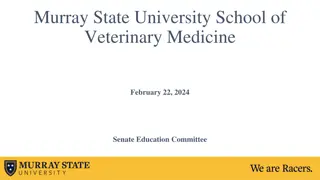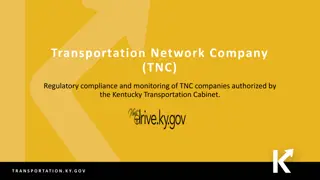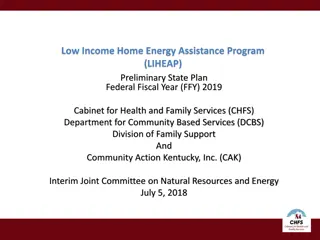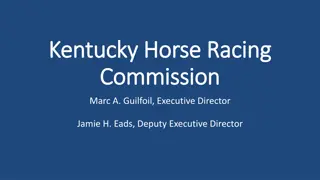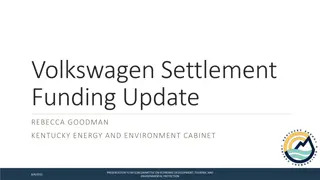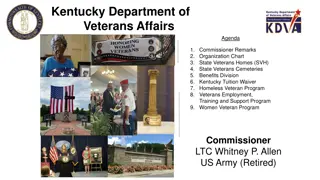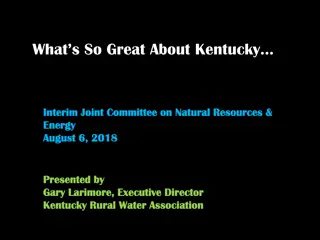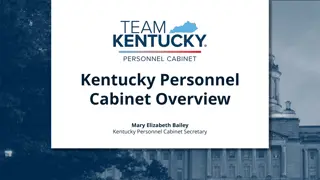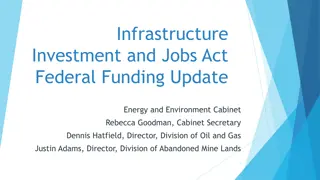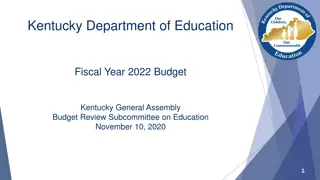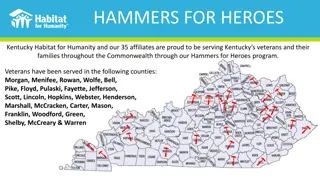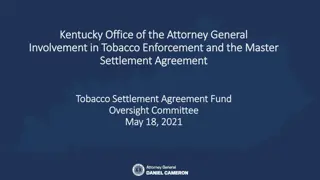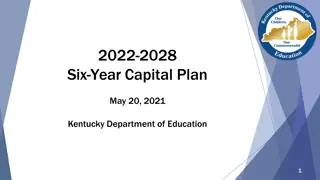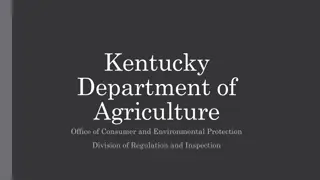Kentucky State University Financial Review Update
Kentucky State University underwent a financial review update led by President Aaron Thompson and Vice President Travis Powell. The review included assessments of cash reserves, financial health, peer group comparisons, and control processes, following an Executive Order signed in July 2021. Findings revealed a liquidity crisis starting in 2019, prompting recommendations for improvement and oversight by the Kentucky Council on Postsecondary Education.
Download Presentation

Please find below an Image/Link to download the presentation.
The content on the website is provided AS IS for your information and personal use only. It may not be sold, licensed, or shared on other websites without obtaining consent from the author.If you encounter any issues during the download, it is possible that the publisher has removed the file from their server.
You are allowed to download the files provided on this website for personal or commercial use, subject to the condition that they are used lawfully. All files are the property of their respective owners.
The content on the website is provided AS IS for your information and personal use only. It may not be sold, licensed, or shared on other websites without obtaining consent from the author.
E N D
Presentation Transcript
Kentucky State University Review Update Aaron Thompson, President Travis Powell, Vice President and General Counsel Kentucky Council on Postsecondary Education November 16, 2021
Overview 1. Executive Order 2. Cash Reserves and Working Capital Analysis 3. Financial Health Assessment 4. Peer Group Comparisons 5. Validation of Financial Information 6. Review of Controls over Financial Management and Reporting 7. Recommendations and Key Takeaways 2
Executive Order On July 20, 2021, the Governor signed an Executive Order requiring CPE to: Assess KSU s current financial status and provide a report to the Governor detailing recommendations prior to the next biennial budget. Assist the KSU Board of Regents in developing a management and improvement plan with identifiable goals and measurable metrics. The plan shall provide for continuing oversight by CPE concerning the implementation of the plan. Make recommendations to the KSU Board of Regents concerning administrative structure and leadership. 3
Cash Flow and Working Capital Analysis Cash Flow and Working Capital Analysis Methodology CPE performed the following to review cash reserves and working capital: Assessed the historical and current situation with the KSU CFO. Reviewed audited financial statements and accounting records. Reviewed related state financial institution statements and accounting records. Interviewed finance and administration staff members. 4
Cash Flow and Working Capital Analysis Cash Flow and Working Capital Analysis Findings MAJOR CASH INFLOWS MAJOR CASH OUTFLOWS Tuition and fees Payments to employees State appropriations Payments to suppliers/service providers Federal/State grants and contracts Payments to students Housing and dining/other auxiliaries Purchases of capital assets/capital improvements Draws on Revenue Anticipation Note Payments for debt service Payments on Revenue Anticipation Note 5
Cash Flow and Working Capital Analysis Cash Flow and Working Capital Analysis Findings Liquidity Crisis Began in 2019 (Dollars in Millions) 2016 2017 2018 2019 2020 Cash & cash equivalents Current liabilities Adjusted operating loss $19.9 $18.7 $18.3 $14.0 $12.3 $8.6 $7.5 $7.1 $2.2 $2.0 $(2.8) $(6.2) $(7.1) $(9.4) $(10.0) Note1: Adjusted operating loss includes state appropriations. Note2: 2020 cash & cash equivalents excludes endowment cash held by ARGI Investment Services. 6
Cash Flow and Working Capital Analysis Cash Flow and Working Capital Analysis Findings Inappropriate cash/working capital management techniques used Failure to pay vendors in a timely manner. Failure to reimburse state construction accounts. Draws from Revenue Anticipation Note. Asset preservation fee receipts used for operations. Failure to follow the Institution s policies related to collection of student receivables. Draws from the endowment with incomplete accounting. Known impact of above is $15.7 million of prior year expenses carried forward to FY 2022. Projected current year shortfall up to $7 million due to structural imbalance of university budget in FY 2022. 7
Cash Flow and Working Capital Analysis Cash Flow and Working Capital Analysis Findings 9/30/21 cash position of $4.34 million was temporarily relieved by: Advancement of fourth quarter allotment from the State ($5.4 million) CARES Act debt forgiveness ($2.5 million) Current projections indicates cash reserves will be depleted by March 2022 and the $5 million Revenue Anticipation Note will be used for April operations. An additional non-recurring appropriation from the General Assembly is needed for continued operations beyond April. 8
Financial Health Assessment Methodology Four Primary Ratios: 1) Primary Reserve 2) Net Operating Revenues 3) Return on Net Assets 4) Viability These ratios were weighted and combined to create a Composite Financial Index (CFI). Audited financial statements were used to compute the ratios. Adjusted to remove pension impact and other post employment benefits. These measures are intended for the evaluation of a single institution over time, rather than comparisons across institutions. 9
Financial Health Assessment Findings Primary Reserve Ratio Industry Standard From 2015-16 to 2017-18 the ratio was relatively financially healthy. In 2018-19, operating expenses increased significantly without a corresponding increase in revenues. Expendable Net Assets 0.40 In 2019-20, despite a reduction, expenses exceeded revenues again and further exacerbated the ratio s decline. Total Expenses Beginning in 2018-19, operating expenses exceeded operating revenues. The structural deficit was financed using available reserves. Fiscal Year 2015-16 2016-17 2017-18 2018-19 2019-20 $32,650,988 $30,827,476 $33,746,076 $18,957,252 $7,292,103 Expendable Net Assets (Reserves) Total Expenses Ratio Days of Expenses Covered By Reserves $62,867,192 $71,351,849 $74,556,167 $82,867,309 $76,155,413 0.52 190 0.43 158 0.45 165 0.23 83 0.10 35 10
Financial Health Assessment Findings Viability Ratio Industry Standard From 2015-16 to 2018-19 the ratio was financially healthy due to: Low levels of plant-related debt. Expendable Net Assets High levels of reserves. 1.0 Plant-related Debt In 2019-20, the ratio declined to a financially stressed level due to: An addition of $13.2 million of plant-related debt. A reduction of $11.7 million in expendable net assets (reserves) from 2018-19. The use of reserves to finance day-to-day operations of the university has limited resource flexibility and ability to meet debt obligations should there be adverse conditions. Fiscal Year 2015-16 2016-17 2017-18 2018-19 2019-20 $32,650,988 $30,827,476 $33,746,076 $18,957,252 $7,292,103 Expendable Net Assets (Reserves) Plant-related Debt Ratio $5,863,231 $5,111,791 $4,257,692 $3,423,306 $16,141,582 5.57 6.03 7.93 5.54 0.45 11
Financial Health Assessment Findings Return on Net Assets Ratio Industry Standard From 2015-16 to 2017-18, there were normal variations in the ratio In 2018-19, there was a significant decline in net assets Change in Net Assets Includes a reduction of $12,376,886 in unrestricted net assets of the institution 3% to 4% Total Net Assets In 2019-20, net assets declined substantially again Real Rate of Return This would have been larger, but federal operating grants and contracts increased by $3,396,633 in the year The university s repeated negative results indicate that investments made using net assets (reserves) were not obtaining the necessary return. Fiscal Year 2015-16 2016-17 2017-18 2018-19 2019-20 $(3,010,998) $1,739,491 $(2,164,769) $(15,358,611) $(4,346,095) Change in Net Assets (Reserves) Total Net Assets (Beginning of the Year) Ratio $117,220,814 $114,209,816 $115,949,307 $113,784,538 -2.57% 1.52% $98,425,927 -4.42% -1.87% -13.50% 12
Financial Health Assessment Findings Net Operating Revenues Ratio Industry Standard From 2015-16 to 2019-20, there were no positive scores From 2015-16 to 2018-19, net operating losses increased with the most dramatic loss occurring in 2018-19 Net Operating Income At least 4% - 6% In 2019-20, the net operating loss decreased largely due to: A substantial increase of $3,396,633 in federal operating grants and contracts An increase in tuition and fee, residence hall, and dining revenues of $1,509,332 total Total Unrestricted Operating Revenues The university s consistent and large negative results indicate that revenue and expense streams are unsustainable and need to be restructured. Fiscal Year 2015-16 2016-17 2017-18 2018-19 2019-20 $(2,188,457) $(3,273,507) $(5,931,127) $(16,367,071) $(4,173,409) Net Operating Income Total Unrestricted Operating Revenues Ratio $60,888,579 -3.59% $68,078,342 -4.81% $68,618,378 -8.64% $66,500,238 -24.61% $71,982,004 -5.80% 13
Financial Health Assessment Findings Composite Financial Index 10 Each of the primary ratios are converted to a score and weighted as follows: Financially Healthy Primary Reserve (35%), Net Operating Revenues (10%), Return on Net Assets (20%), Viability (35%) 3 Relatively From 2015-16 to 2017-18, the CFI shows the university is relatively financially healthy. Financially Healthy In 2018-19, the CFI drops below the relatively financially healthy level. 1 Financially Stressed In 2019-20, the CFI shows a rapid decline from financially stressed to unhealthy. Results vary significantly from what was previously reported per HB 303 (2016). -4 Financially Unhealthy KSU s descent into a financially unhealthy condition was driven by poor performance in the Primary Reserve and Viability Ratios which make up 70% of the score. The Net Operating Revenues Ratio shows the structural imbalances causing the institution to finance operations with reserves, negatively affecting all three of the other ratios. Fiscal Year Fiscal Year CFI Score Previously Reported CFI Score Computed by CPE 2015 2015- -16 16 2016 2016- -17 17 2017 2017- -18 18 2018 2018- -19 19 2019 2019- -20 20 4.08 4.08 4.33 4.33 8.35 8.35 4.42 4.42 8.90 8.90 4.10 4.10 5.72 5.72 2.90 2.90 3.94 3.94 - -0.21 0.21 14
Peer Group Comparisons Methodology KSU Comparison Group Institutions CPE staff worked with KSU officials to identify criteria for developing a customized comparison group, using the IPEDS Data Feedback Report Selection criteria: HBCU land-grant institution located in continental United States public four-year degree granting, baccalaureate and above enrollment between 1,000 and 3,600 The resulting comparison group included eight institutions Alcorn State University (Alcorn State, MS) Central State University (Wilberforce, OH) Fort Valley State University (Fort Valley, GA) Langston University (Langston, OK) Lincoln University (Jefferson City, MO) South Carolina State University (Orangeburg, SC) University of Arkansas at Pine Bluff (Pine Bluff, AR) University of Maryland Eastern Shore (Princess Anne, MD) 15
Peer Group Comparisons Findings Affordability KSU s published in-state sticker price is above the peer median. In 2021, resident undergraduate tuition and fees at KSU ranked 2nd highest out of nine HBCUs and were 113% of the comparison group median. Between 2017 and 2021, published in-state prices grew more slowly at KSU (+13%) than the group median (+16%). KSU s net price is considerably lower than that of peer institutions. In 2019, KSU had the lowest average net price of college attendance (i.e., ranked 9th) of any peer institution, registering 60% of the group median. Between 2017 and 2019, KSU s net price decreased from $9,561 to $7,363 or by 23%, while the group median decreased by 1%. 16
Peer Group Comparisons Findings Sources of Core Revenue KSU s tuition and fee, state appropriations, and government grants and contracts revenue per student are higher than group medians. In 2020, KSU s tuition and fee revenue per student ranked 2nd highest and was 155% of the group median, its state appropriations per student ranked 2nd highest and were 156% of the median, and its governmental grants and contracts per student ranked 1st (highest) and were 144% of the median. 17
Peer Group Comparisons Findings Staffing Levels Compared to its peers, KSU employs fewer postsecondary teachers and instructional support staff During fall 2020, the number of postsecondary teachers and staff employed by KSU ranked 8th lowest out of nine HBCUs and was 75% of the group median. The number of staff employed by KSU in instructional support occupations ranked 7th lowest and was 33% of the comparison group median. and more management and business and financial operations staff. That same semester, the number of management staff employed by KSU ranked 3rd highest and was 127% of the group median. The number of staff employed by KSU in business and financial operations ranked 4th highest and was 125% of the group median. 18
Peer Group Comparisons Findings Staffing Levels (Cont d) Compared to its peers, KSU employs more computer, engineering, and science staff During fall 2020, the number of computer, engineering and science staff employed by KSU ranked 1st (highest) out of nine HBCUs and was 161% of the comparison group median. and more community service, legal, arts, and media staff. The number of staff employed by KSU in community service, legal, arts and media occupations ranked 3rd highest and was 153% of the group median. 19
Peer Group Comparisons Findings Faculty Compensation For the most part, average salaries of faculty employed by KSU are either at, or slightly above, the median of peer institutions. During academic year 2020-21, the average nine-month equivalent salary of associate professors employed by KSU ranked 5th out of nine HBCUs and was 100% of the comparison group median. The average salary of assistant professors employed by KSU ranked 4th highest and was 103% of the group median. The average salary of instructors ranked 5th and was 102% of the group median. The average salary of full professors at KSU is below the peer median. In 2020-21, the average salary of full professors employed by KSU ranked 7th lowest and was 92% of the peer group median. 20
Peer Group Comparisons Findings Student Success KSU s degree production is the lowest among peer institutions. In 2019-20, KSU awarded 9 bachelor s degrees for every 100 FTE students, lowest among peer ground and 54% of the median. In 2016-2017, KSU ranked first at 157% of the median. KSU s graduation rate is below the peer median. For the 2013 cohort, KSU s graduation rate among first-time, full-time degree seeking students within 150% of normal time was nine percentage points below the comparison group median (KSU 25%; median 34%). KSU s retention rate is the highest among peer institutions. For the fall 2019 cohort, KSU s retention rate among first-time, full-time bachelor s degree seeking students was the highest (ranked 1st) out of nine HBCUs and was seven percentage points above the group median (KSU 78%; median 71%). 21
Validation of Financial Information Research Question, Methodology, Preliminary Findings Research question: Is the KSU financial information communicated to key stakeholders accurate? Methodology: Validate all financial information presented by the KSU CFO to the KSU Board of Regents and external parties Verified to audited financial statements and other information from: Financial institutions Commonwealth of KY Federal agencies (Department of Education and USDA) Accounting system/Argos report-writer linked to Banner Internal accounting analysis Findings: All information communicated externally since the issuance of the Executive Order has been accurate. 22
Review of Controls over Financial Management and Reporting Methodology Reviewed key financial functions and related policies, procedures and internal controls: Accounting System and Related Reporting Internal Audit Treasury Management (encompasses Debt, Endowment, Long-Range Planning) Student Accounts Receivable/Collections Budget Management and Interim Financial Reporting Enterprise Risk Management Reviewed historical audited financial statements including OMB Uniform Guidance reports and other items (ex. HB 303 (2016) Reports, Gold Book). Invited KSU Finance & Administration staff members to share information or concerns related to KSU operations. 23
Review of Controls over Financial Management and Reporting Findings Banner accounting system and related Argos reporting tool is inadequate. Formal upgrade and training is needed, including a financial reporting module to produce GAAP statements. Internal audit function was non-existent for approximately three years and the KSU Tip Line was discontinued in 2017 and has yet to be reinstated. Current internal audit function, beginning in early 2020 and comprised of one FTE, has been ineffective in providing a comprehensive, risk-based audit approach with regular communication to the Board of Regents. No written policies related to treasury management, with exception of an endowment investment policy (last updated in 2012). Formal endowment spending policy should also be incorporated. 24
Review of Controls over Financial Management and Reporting Findings No long range financial planning function exists. Institutions typically forecast at least five years. Failure to follow policies related to collection of student receivables. Lack of sufficient budgetary controls and failure to follow existing policies. Inadequate interim financial reporting (i.e. quarterly GAAP statements and budget to actual comparisons, dashboards, etc.). No enterprise risk management function exists. The financial health ratios and resulting CFI scores presented by KSU senior leadership in its HB 303 (2016) reports were inconsistent with CPE staff calculations and reflected a more favorable financial position. Numerous external financial audit findings and consistently missed audited financial statement deadlines. 25
Budget Request to Cover FY 2022 Projected Cash Shortfall and Strategic Initiatives Deficit construction accounts with State Finance Cabinet Prior year invoices paid in FY 2022 Asset Preservation Fee Receipts Not Reserved (2019-21) July Repayment of prior year Revenue Anticipation Note $5.2 million $4.3 million $1.2 million $5.0 million FY 2022 Cash Shortfall due to prior year deficits $15.7 million Structural Imbalance in FY 2022 University Budget $7.0 million FY 2021-22 Total Projected Cash Shortfall 2022-2024 Biennium Strategic Initiatives $23.0 million $1.0 million/yr. 26
Recommendations Cultivate a culture of accountability, transparency and compliance (established by the tone at the top). Improve budgetary controls and provide a quarterly budget to actual report to the Board of Regents. Improve the accounting and reporting system and internal controls over financial reporting; provide quarterly GAAP statements and other financial information to the Board of Regents. Outsource or co-source the Internal Audit function and reinstate the externally managed tip line. Implement a formal accounting and reporting framework for endowment distributions. Improve collection of student accounts receivable, including implementation of a formal Statement of Financial Responsibility and utilization of external collection agencies, including Kentucky s Department of Revenue. Complete a comprehensive review of expenses to ensure expenses are charged to the correct functional area and that costs are appropriately allocated to grants and auxiliary units. 27
Recommendations Complete a review of academic programs and establish appropriate faculty productivity metrics. Implement a long-range planning process to support the strategic and capital investment decision-making process. Implement an enterprise risk management process to identify, evaluate and mitigate key risks facing the institution and higher education industry, including strategic, operational, financial and compliance risks. Develop appropriate policies and procedures governing the key functions of treasury management including cash management, operating investment management, debt management and internal loans. Review and update the Endowment Investment Policy and incorporate a formal spending policy within the investment policy. Implement quarterly reporting to the Board of Regents the President's travel, entertainment and discretionary expenses. 28
Key Takeaways Significant operating deficits in recent years (especially 2019 forward) have resulted in the depletion of KSU s cash reserves Current structural deficit is unsustainable Poor leadership over financial management Inadequate budgetary controls Inadequate internal and external financial reporting Inadequate internal audit function KSU compares very favorably to its peers in state appropriations, government grants and contracts, and tuition and fee revenue per student 29
Management and Improvement Plan Areas 1. Comprehensive cataloging and review of university policies and procedures to ensure efficiency and compliance with state and federal law. 2. Guidelines for salary ranges and benefits for all faculty, staff and administrators. 3. Board member training and development, including but not limited to financial oversight and effective committee structure. 4. Organizational structure and development of human infrastructure. 5. Academic program offerings, course offerings and faculty productivity guidelines. 6. Accounting and fiscal reporting systems, collections, budget, and internal controls over expenditures and financial reporting. 7. Student success and enrollment management strategies. 30
KSU Presidential Search Committee 11 Members CPE Representative (Chair) KSU Faculty (2) KSU Staff (2) KSU Students (2) KSU Alumni (2) Frankfort Community Member (1) Frankfort K-12 Representative (1) No Current KSU Board of Regents Members Serving Executive Search Firm: Myers McRae 31
Questions Questions? Twitter: CPENews and CPEPres Facebook: KYCPE Website: http://cpe.ky.gov


